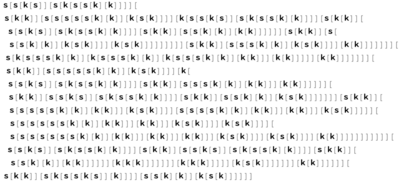Binary combinatory logic
This article provides insufficient context for those unfamiliar with the subject. (July 2020) (Learn how and when to remove this template message) |
Binary combinatory logic (BCL) is a computer programming language that uses binary terms 0 and 1 to create a complete formulation of combinatory logic using only the symbols 0 and 1.[1] Using the S and K combinators, complex boolean algebra functions can be made. BCL has applications in the theory of program-size complexity (Kolmogorov complexity).[1][2]
Definition
S-K Basis
Utilizing K and S combinators of the Combinatory logic, logical functions can be represented in as functions of combinators:
| Boolean Algebra | S-K Basis | |
|---|---|---|
| True(1) | K(KK) | |
| False(0) | K(K(SK)) | |
| AND | SSK | |
| NOT | SS(S(S(S(SK))S))(KK) | |
| OR | S(SS)S(SK) | |
| NAND | S(S(K(S(SS(K(KK)))))))S | |
| NOR | S(S(S(SS(K(K(KK)))))(KS)) | |
| XOR | S(S(S(SS)(S(S(SK)))S))K |
Syntax
<term> ::= 00 | 01 | 1 <term> <term>
Semantics
The denotational semantics of BCL may be specified as follows:
[ 00 ] == K[ 01 ] == S[ 1 <term1> <term2> ] == ( [<term1>] [<term2>] )
where "[...]" abbreviates "the meaning of ...". Here K and S are the KS-basis combinators, and ( ) is the application operation, of combinatory logic. (The prefix 1 corresponds to a left parenthesis, right parentheses being unnecessary for disambiguation.)
Thus there are four equivalent formulations of BCL, depending on the manner of encoding the triplet (K, S, left parenthesis). These are (00, 01, 1) (as in the present version), (01, 00, 1), (10, 11, 0), and (11, 10, 0).
The operational semantics of BCL, apart from eta-reduction (which is not required for Turing completeness), may be very compactly specified by the following rewriting rules for subterms of a given term, parsing from the left:
1100xy → x11101xyz → 11xz1yz
where x, y, and z are arbitrary subterms. (Note, for example, that because parsing is from the left, 10000 is not a subterm of 11010000.)
BCL can be used to replicate algorithms like Turing machines and Cellular automata,[3] BCL is Turing complete.
See also
References
- ↑ 1.0 1.1 Tromp, John (2007), "Binary lambda calculus and combinatory logic", Randomness and complexity, World Sci. Publ., Hackensack, NJ, pp. 237–260, doi:10.1142/9789812770837_0014, ISBN 978-981-277-082-0, https://tromp.github.io/cl/LC.pdf.
- ↑ Devine, Sean (2009), "The insights of algorithmic entropy", Entropy 11 (1): 85–110, doi:10.3390/e11010085, Bibcode: 2009Entrp..11...85D
- ↑ 3.0 3.1 3.2 Wolfram, Stephen (2021-12-06). "Combinators: A Centennial View" (in en). https://writings.stephenwolfram.com/2020/12/combinators-a-centennial-view/.
Further reading
- Tromp, John (October 2007). "Binary Lambda Calculus and Combinatory Logic". Randomness and Complexity, from Leibniz to Chaitin: 237–260. doi:10.1142/9789812770837_0014. ISBN 978-981-277-082-0. https://drops.dagstuhl.de/opus/volltexte/2006/628/.
External links
- John's Lambda Calculus and Combinatory Logic Playground
- A minimal implementation in C
- Lambda Calculus in 383 Bytes
 |


